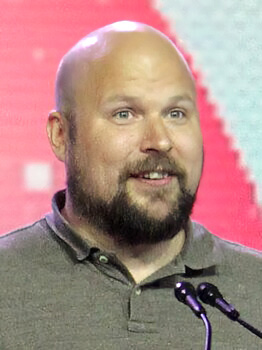Mojang Studios facts for kids

The Mojang Studios logo used since 2020
|
|

Headquarters in Stockholm, Sweden, in 2022
|
|
|
Trade name
|
Mojang Studios (2020–present) |
|---|---|
|
Formerly
|
Mojang Specifications (2009–2010) |
| Subsidiary | |
| Industry | Video games |
| Founded | 18 June 2009 |
| Founder | Markus Persson |
| Headquarters |
,
Sweden
|
|
Number of locations
|
5 (2021) |
|
Key people
|
Kayleen Walters (studio head) |
| Products | Minecraft series |
|
Number of employees
|
≈600 (2021) |
| Parent | Xbox Game Studios (2014–present) |
Mojang AB, also known as Mojang Studios, is a Swedish video game developer located in Stockholm. It is part of Xbox Game Studios and is famous for creating Minecraft, the best-selling video game of all time.
Mojang was founded by a game designer named Markus Persson in 2009. He started the company, first called Mojang Specifications, to develop his new game, Minecraft. After the game became popular, Persson and his friend Jakob Porsér officially created the company Mojang AB in 2010. They hired Carl Manneh to help run the business.
Minecraft became a huge success and helped Mojang grow quickly. In 2014, Persson decided he wanted to move on to other things and sold Mojang to Microsoft. After the sale, Persson, Porsér, and Manneh left the company. In 2020, Mojang changed its name to Mojang Studios to show that it had grown into a company with multiple teams and offices.
As of 2021, Mojang Studios has about 600 employees. Besides Minecraft, the studio has made other games like Caller's Bane, Crown and Council, Minecraft Dungeons, and Minecraft Legends.
Contents
History
How Mojang Started (2009–2010)

Mojang Studios was started by Markus Persson, a Swedish game designer who loved video games since he was a kid. He learned to program when he was only eight years old. As a young man, he worked on several games before deciding to create his own.
In May 2009, Persson began working on a new game inspired by another game called Infiniminer. He released the first version of his game, which he called Minecraft, on May 17, 2009. He used the name "Mojang Specifications" for his one-person company. The word "mojäng" is Swedish for "gadget."
Minecraft quickly started making enough money for Persson to quit his day job and focus on the game full-time. In September 2010, he and his friend Jakob Porsér officially created the company Mojang AB. While Persson worked on Minecraft, Porsér began developing another game called Scrolls. They hired Carl Manneh to be the chief executive officer (CEO) so they could focus on making games.
Growing with Minecraft (2011–2013)
By January 2011, Minecraft had one million players, and just six months later, it had ten million. This success allowed Mojang to create new versions of the game for mobile phones and the Xbox 360 console.
In November 2011, Mojang held the first Minecon, a special convention for Minecraft fans, in Las Vegas. At the event, the full version of Minecraft was officially released. After the release, Persson passed the role of lead designer for Minecraft to Jens Bergensten, also known as "Jeb," so he could work on new ideas.
The company became very successful. By 2012, Mojang had 25 employees and had earned over $237 million. The company was so successful that it didn't need to borrow money from big investment companies. They wanted to stay independent to keep making games their own way.
Becoming a Microsoft Company (2014–present)
By 2014, Markus Persson felt tired from the pressure of owning such a popular game. In June, he posted a message on Twitter asking if anyone would want to buy his shares of the Mojang company. Companies like Activision Blizzard, Electronic Arts, and Microsoft were interested.
Microsoft, which makes the Xbox console, saw a great opportunity. On September 15, 2014, Microsoft announced it would buy Mojang for $2.5 billion. The deal was completed on November 6, and Mojang became a part of Microsoft Studios (now known as Xbox Game Studios). After the sale, Persson, Porsér, and Manneh left the company.
Even though Microsoft owned Mojang, the studio was allowed to keep its independence and culture. This helped Mojang continue to work on Minecraft and create new games.
In May 2020, on Minecraft's 11th anniversary, the company was renamed Mojang Studios. This new name and logo were chosen to show that the company had grown to include several studios and teams working on different projects in the Minecraft universe.
Games Developed by Mojang
| Year | Title | Platform(s) | Notes |
|---|---|---|---|
| 2011 | Minecraft | Android, iOS, Linux, macOS, Windows, and many consoles | The best-selling video game of all time. |
| 2014 | Caller's Bane | Android, macOS, Windows | Originally known as Scrolls. |
| 2016 | Crown and Council | Linux, macOS, Windows | A free strategy game. |
| 2020 | Minecraft Dungeons | Nintendo Switch, PlayStation 4, Windows, Xbox One | An action-adventure game set in the Minecraft universe. |
| 2023 | Minecraft Legends | Nintendo Switch, PlayStation 4, PlayStation 5, Windows, Xbox One, Xbox Series X/S | An action-strategy game. |
Unreleased and Canceled Games
Over the years, Mojang has worked on a few games that were never released.
One interesting project was a game codenamed Rex Kwon Do, which was meant to be a mix of Minecraft and Lego bricks. Mojang worked with The Lego Group on the idea, but the project was canceled after about six months so the team could focus on its own games.
Another planned game was a space adventure called 0x10c. Markus Persson announced it in 2012, but he stopped working on it a year later because he lost interest in the project.
Mojang also released Minecraft Earth, an augmented reality game similar to Pokémon Go. It was shut down in 2021 because the global pandemic made it difficult for people to play a game that required moving around outside.
See also
 In Spanish: Mojang Studios para niños
In Spanish: Mojang Studios para niños


